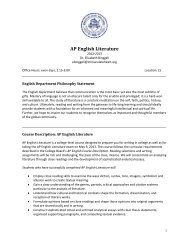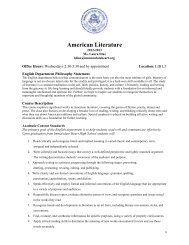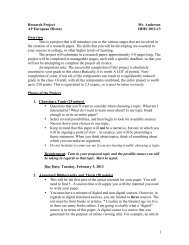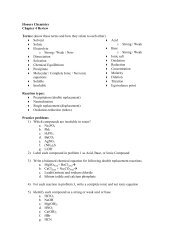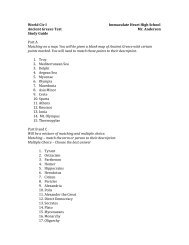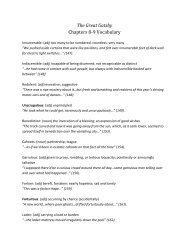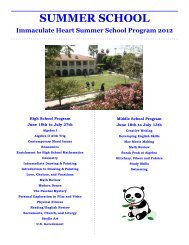Syllabus - Immaculate Heart High School
Syllabus - Immaculate Heart High School
Syllabus - Immaculate Heart High School
Create successful ePaper yourself
Turn your PDF publications into a flip-book with our unique Google optimized e-Paper software.
Algebra II<br />
2012-2013<br />
Mrs. Jessica Quinn<br />
jquinn@immaculateheart.org<br />
Office Hours: Afterschool, or by appointment at break or lunch<br />
Location: U2<br />
Department Philosophy Statement<br />
Knowledge of mathematics and creativity in its application have become more critical than ever in our<br />
contemporary world. This knowledge and accompanying skills are essential for young women to be<br />
able to discern carefully, to choose wisely, to realize their own unique potential and to function as<br />
intelligent, informed and contributing members of their society and the global community.<br />
The mathematics department attempts to provide the solid foundation in mathematics necessary to<br />
encourage and inspire students to continue their study of the discipline and related subjects beyond<br />
the high school level and for the rest of their lives. A population that is “numerate” is a necessity for a<br />
technological society that is continually changing and ever increasing in complexity.<br />
Course Description<br />
Algebra II is a continuation of the study of mathematics begun in both Algebra I and Geometry. It marks<br />
the end of the required portion of the mathematics curriculum and may be the foundation for further<br />
studies in math. In Algebra II we will review and expand upon topics from Algebra I, particularly<br />
simplifying expressions, solving equations, and graphing. We will explore several new kinds of functions<br />
and look at some of the applications of algebra to everyday situations.<br />
Students in Algebra II should have successfully completed Algebra I and Geometry. Note: this class does<br />
not meet the prerequisites for the Pre-Calculus or AP Statistics courses.<br />
Academic Content Standards (Common Core Standards)<br />
Upon graduation from <strong>Immaculate</strong> <strong>Heart</strong> <strong>High</strong> <strong>School</strong> students will:<br />
1) Make sense of problems and persevere in solving them.<br />
2) Reason abstractly and quantitatively.<br />
3) Construct viable arguments and critique the reasoning of others.<br />
4) Model with mathematics.<br />
5) Use appropriate tools strategically.<br />
6) Attend to precision.<br />
7) Look and make use of structure.<br />
8) Look for and express regularity in repeated reasoning.<br />
1
Course Chronology:<br />
First Semester<br />
Equations and Inequalities<br />
Linear Equations and Functions<br />
Systems of Linear Equations & Inequalities<br />
Matrices<br />
Quadratic Functions<br />
Second Semester<br />
Polynomial Expressions and Functions<br />
Power Functions<br />
Exponential and Logarithmic Functions<br />
Rational Equations and Functions<br />
Sequences and Series<br />
Probability<br />
Required Materials<br />
Algebra 2: Applications, Equations, Graphs, by Larson, Boswell, Kanold, and Stiff, published by<br />
McDougal Littell, 2011.<br />
Three-ring binder to organize notes, handouts, homework and quizzes.<br />
TI-83 Plus/TI-84 Plus graphing calculator.<br />
Paper, graph paper, ruler with inches and centimeters, pencil (mechanical is preferred), eraser.<br />
Classroom Expectations:<br />
Participation: Students are expected to be participants in the learning process. Your<br />
contribution to the environment - positive or negative - will be considered when the semester<br />
grade is calculated. Participation includes, but is not limited to, making relevant observations,<br />
asking & answering questions, remaining on task, having your binder up-to-date, being civil and<br />
helpful, having course materials, attending regularly and being on time.<br />
Web Pages: Assignments and announcements of quizzes and exams will be made in class and<br />
on the class’s webpage. Every effort is made to update the page after each class meeting.<br />
Make-Up Tests: Generally, students with extended absence for illness have as many days to<br />
make up an exam. (Please see me as soon as you return.) Quizzes that have been graded and<br />
returned cannot be made-up, however a student who misses a quiz will be given a blank copy<br />
for study purposes without penalty.<br />
A student who is absent the period before a test, but present when the test was scheduled,<br />
should contact me before the test if she feels she is not prepared to take it with the class.<br />
A student who is absent on the test day only should contact me to schedule a time to take the<br />
test on the day she returns.<br />
Make up Work: Regular attendance is critical for success in mathematics as the class work<br />
supplements the material presented in the textbook and vice versa. If an absence is<br />
unavoidable, I expect the student to read the text, obtain the notes and help from another<br />
student and make an effort to complete the assignment(s). If there are questions, bring the<br />
notes to office hours/appointment for clarification as soon as possible.<br />
2
Homework: Homework is assigned on a daily basis and will be listed on the class web page.<br />
Homework is checked AT THE BEGINNING OF CLASS on the day the assignment is due. Late<br />
homework will be accepted up to one week after the assignment was originally due. You may<br />
turn in two late homework assignments each quarter with no penalty. After these two late<br />
assignments, late work will be awarded half credit.<br />
Technology: Graphing calculators will be used extensively for in-class work. Calculators may be<br />
used on all homework assignments unless otherwise specified.<br />
Cell phones and other technology may never be used in class and I highly recommend turning<br />
off cell phones and other electronic devices while completing homework. Unauthorized use in<br />
class will result in a detention.<br />
Academic Integrity: You are expected to adhere to the principles stated in the Academic<br />
Integrity Policy and any deviation from there will have consequences.<br />
Test Return Policy: Quizzes will be returned for students to keep in their binders. Chapter tests<br />
will remain in my custody.<br />
Other classroom rules: All classroom rules and regulations regarding conduct, attendance,<br />
dress code, grading, plagiarism, etc. shall be implemented and followed as stated in the school<br />
handbook.<br />
Types of Assessments:<br />
Homework: Homework assignments are worth two points each. All regular homework assignments<br />
must include the following elements:<br />
Your name<br />
Assignment Name (including the page number and problems)<br />
Each assigned problem must include:<br />
a. the original problem and any picture or graph that is associated with it (you may paraphrase<br />
long word problems)<br />
b. sufficient work written in a logical, neat and organized way<br />
c. your proposed solution<br />
Check the odd-numbered problems in the back of the book before class. Use a red pen to show that the<br />
work has been corrected. Try Hotmath.com for extra help on homework problems. Use the<br />
password: xe63070de . Ask questions about your homework the following day. Corrections are made<br />
during the first ten minutes of class and it is important to pay attention to this part of the class. Each<br />
problem on the assignment should be attempted in order to receive credit for the assignment.<br />
The website associated with the text,<br />
http://www.classzone.com/cz/books/algebra_2_2011_na/login.htm , has resources such as extra<br />
examples, self-check quizzes and a parent and student study guide.<br />
3
Quizzes/Tests: Generally, there will be 2 quizzes per chapter worth about 50 points each. Quizzes are<br />
primarily free-response. Chapter Tests will include some multiple choice questions along with free<br />
response and be worth 100 points.<br />
Participation: A participation grade will be assigned once each quarter to reflect the behaviors<br />
described in the classroom expectations. It will be worth approximately 10% of the points possible for<br />
the quarter and be based on my recollection of your engagement in the learning process in class during<br />
the quarter.<br />
Semester Exam: A comprehensive semester exam covering the semester’s content will be given at the<br />
end of the semester and worth 25% of the semester grade.<br />
Grading Policy:<br />
75% of each semester grade will be based on a percentage of total points of tests (100 points each),<br />
quizzes (30-50 points each) and homework assignments (2 points each) .<br />
25% of each semester grade will be based on the final exam.<br />
100-93 A 89-87 B+ 79-77 C+ 69-67 D+ 59-0 F<br />
92-90 A- 86-83 B 76-73 C 66-63 D<br />
82-80 B- 72-70 C- 62-60 D-<br />
4
Benchmarks and Performance Standards Revised 8/12<br />
Simplify algebraic expressions .<br />
Solve linear equations and inequalities .<br />
Solve absolute value equations and inequalities .<br />
Graph linear equations and inequalities .<br />
Graph absolute value equations .<br />
Graph scatter plots, fine lines of best fit, and identify correlation coefficients given data sets.<br />
Solve systems of linear equations and inequalities by graphing, substitution, and elimination.<br />
Simplify expressions with matrices.<br />
Write and solve matrix equations representing systems of linear equations.<br />
Solve quadratic equations with real and complex solutions by factoring, completing the square,<br />
and using the quadratic formula .<br />
Simplify expressions with complex numbers .<br />
Understand the connections between the graphs of absolute value and quadratic functions .<br />
Graph quadratic functions and identify characteristics.<br />
Understand the relationship between solutions of an equation, factors of an expression, zeros of<br />
a functions, and x-intercepts of a graph.<br />
Simplify polynomial expressions, including addition, subtraction, and multiplication.<br />
Factor polynomials using various methods .<br />
Simplify expressions with rational exponents .<br />
Solve equations involving rational exponents and radicals .<br />
Understand function notation, composition of functions, and the inverse of a function .<br />
Simplify logarithmic and exponential expressions.<br />
Solve problems involving exponential growth or decay, including population growth and<br />
compound interest.<br />
Solve logarithmic and exponential equations .<br />
Graph logarithmic and exponential equations .<br />
Simplify rational expressions with monomial and polynomial denominators.<br />
Simplify complicated rational expressions including complex fractions and expressions with<br />
rational exponents .<br />
Solve rational equations .<br />
Find the next term and n th term of arithmetic and geometric sequences.<br />
Find the finite or infinite sums of arithmetic and geometric series, if they exist.<br />
Use summation notation to represent series.<br />
Understand the Fundamental Counting Principle and be able to compute numbers of<br />
permutations and combinations.<br />
Find theoretical, experimental, and geometric probabilities.<br />
Find the probability of compound events and independent and dependent events.<br />
5




